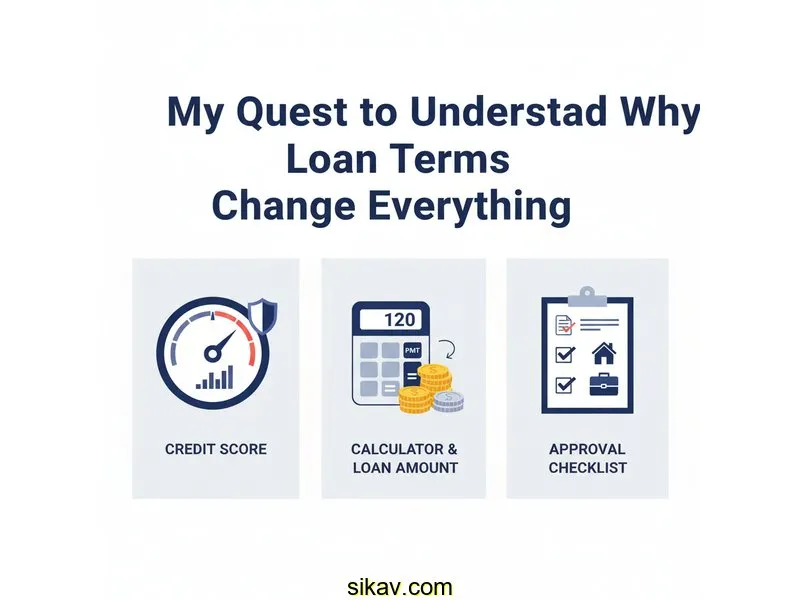
Auto Loan Calculator
Calculate payments over the life of your Loan
Home Blog Privacy Terms About Contact
Calculate payments over the life of your Loan
Home Blog Privacy Terms About ContactPublished on October 14, 2025

It all started with a simple question that I couldn't shake. I was looking at some hypothetical loan scenarios online, just playing around with numbers, and I noticed something that felt counterintuitive. For the exact same loan amount, one option had a comfortably low monthly payment, while another had a payment that was noticeably higher. My brain immediately told me, "Well, the lower payment is obviously the better deal, right?"
But a little voice in the back of my head whispered, "Is it really that simple?" How could two loans for the same amount of money, with the same interest rate, have such different payments? And more importantly, did that lower payment come with a hidden cost I wasn't seeing? I realized I was only looking at one number—the monthly payment—and I had no idea how it connected to the total cost of the loan. This wasn't about making a financial decision; it was about pure, nagging curiosity. I needed to understand the math behind the curtain.
My initial attempts were clumsy. I'd plug numbers into a basic online calculator, see the monthly payment, and just stare at it. I didn't know what to do with the other information on the screen, like "total interest paid" or "amortization schedule." They were just words to me. My goal became singular: to understand the relationship between the time you take to pay back a loan and the actual, final dollar amount you end up paying. I wanted to see the mechanics of it all.
This article is the story of that journey. It’s about how I went from being confused by these numbers to finally understanding how they all work together. This is about understanding how calculations work, not financial advice. My hope is that by sharing my process, I can help demystify some of this math for others who are just as curious as I was.
My main point of confusion was rooted in a very specific scenario I had created for myself. I imagined a loan for $14,850 at an interest rate of 6.8%. I used an online loan calculator and first entered a term of 60 months (5 years). The calculator spit out a monthly payment of around $293.44. Then, just to see what would happen, I changed the term to 48 months (4 years), keeping everything else the same.
The new monthly payment was $355.88. My immediate, gut reaction was to focus on the monthly cash flow. A payment of $293 felt so much more manageable than $355. That's a difference of over $62 a month. My brain automatically flagged the 60-month option as the "cheaper" one because the monthly bill was lower. I was stuck in a loop, thinking only about the number that would leave my bank account each month.
This is where the frustration set in. I knew, logically, that paying something over a longer period probably meant it cost more in the end, but I couldn't *see* it. I didn't know how to calculate it. I tried to do the math myself. I multiplied the loan amount by the interest rate ($14,850 * 0.068) and got $1,009.80. But what did that number mean? Was that the interest per year? How did that translate into the total cost? It was just a floating number without context.
The online calculators showed fields like "Total Principal Paid" and "Total Interest Paid," but I was ignoring them. They seemed like secondary information. My eyes were glued to that big, bold monthly payment number. It was the moment I realized I was comparing apples and oranges; I was comparing a short-term cash flow number with a long-term cost, and I didn't have the tools to connect them. I wasn't just using the calculator wrong; I was thinking about the problem wrong from the very beginning.

The breakthrough came when I forced myself to slow down and look at every single field in the loan calculator. Instead of just inputting the numbers and glancing at the payment, I decided to dissect the entire output. I ran my two scenarios for the $14,850 loan at 6.8% side-by-side: one for 48 months and one for 60 months. And that’s when I finally paid attention to the "Total Interest Paid" field. It was like a lightbulb flickered on.
For the 60-month loan with the "cheaper" $293.44 payment, the total interest was $2,756.40. For the 48-month loan with the higher $355.88 payment, the total interest was only $2,232.24. Seeing those two numbers next to each other was the jolt I needed. The loan with the lower monthly payment cost over $524 more in the long run. Suddenly, the loan term wasn't just a measure of time; it was a powerful lever that directly controlled the total cost of borrowing money.
The most powerful lesson was learning the simple formula for total cost: Monthly Payment x Loan Term in Months = Total Payments. This seems so basic in hindsight, but it's something I had never stopped to do. Calculating this for both scenarios laid the truth bare. The 60-month loan meant I'd pay a total of $17,606.40. The 48-month loan's total was $17,082.24. The difference was right there in plain sight.
My next step was clicking the "Show Amortization Schedule" button. This was another game-changer. I saw a table that broke down every single payment for the life of the loan. For the 60-month loan, my first payment of $293.44 included $84.15 of interest and only $209.29 toward the principal. For the 48-month loan, the first payment of $355.88 included the same $84.15 of interest, but $271.73 went to principal. I was paying down the actual debt faster with the shorter-term loan, which meant less interest could accrue in the following months.
To make sure this wasn't a fluke, I started running more tests. I tried a smaller loan amount: $9,500 at 7.2%. Over 36 months, the total interest was about $1,085. Over 48 months, it jumped to about $1,448. The pattern held true every single time. A longer term always resulted in a lower monthly payment but a higher total interest cost. I finally had the vocabulary and the math to understand the trade-off I was seeing.
This whole experience was incredibly eye-opening. It wasn't about finding the "best" loan, but about gaining the literacy to understand what the numbers were actually telling me. It shifted my perspective from being a passive observer of calculator outputs to an active participant in understanding them. Here are the most important things I learned about the calculations themselves.
As I went through this process, I kept asking myself questions. Here are some of the key ones that I found answers to, framed in a purely educational way.
The loan term directly impacts the number of times interest is calculated. Interest is typically calculated monthly on the outstanding loan balance. A longer term (e.g., 60 months vs. 48) means your principal balance decreases more slowly, and therefore, you have more months where interest is being charged on a higher balance. Even with the same interest rate, more time equals more interest charges.
This comes down to the difference between cash flow and total cost. A lower monthly payment is achieved by stretching the same loan amount over more payments. While each individual payment is smaller, you are making more of them. The sum of all those smaller payments (the Total Payments) often ends up being significantly higher than the sum of fewer, larger payments for a shorter-term loan.
From my experience, the key is to hold all other variables constant. Use the exact same loan amount and interest rate. First, enter the shorter term (e.g., 36 months) and write down the monthly payment and, most importantly, the total interest paid. Then, change only the term to the longer option (e.g., 48 months) and compare the new total interest figure to the first one. This isolates the impact of the term itself.
It shows how each dollar of your monthly payment is being allocated. The "principal" portion is the part that reduces your actual loan balance. The "interest" portion is the cost of borrowing for that month, which goes to the lender. An amortization schedule shows that in the beginning of a loan, a larger chunk of your payment is interest. As you pay down the principal, the interest portion of each subsequent payment gets smaller.
My journey started with a simple point of confusion: why would a lower monthly payment not be the better deal? After spending time with calculators and truly exploring every field, the answer became crystal clear. It's all about a fundamental trade-off between monthly affordability and the total cost of borrowing. A longer loan term makes the monthly payments more manageable, but that convenience comes at the mathematical cost of higher total interest.
There isn't a "right" or "wrong" answer here; it's just math. My goal was never to decide which loan to take, but to arm myself with the knowledge of how these numbers interact. Understanding that relationship is empowering. It transforms confusing financial jargon into a simple, predictable system. It removes the mystery and replaces it with clarity.
I encourage anyone who feels intimidated by these calculations to simply start playing with the tools. Change one variable at a time and watch how the others react. That simple act of exploration was my key to unlocking a new level of understanding. Seeing the cause and effect for yourself is the best teacher.
This article is about understanding calculations and using tools. For financial decisions, always consult a qualified financial professional.
Disclaimer: This article documents my personal journey learning about loan calculations and how to use financial calculators. This is educational content about understanding math and using tools—not financial advice. Actual loan terms, rates, and costs vary based on individual circumstances, creditworthiness, and lender policies. Calculator results are estimates for educational purposes. Always verify calculations with your lender and consult a qualified financial advisor before making any financial decisions.
